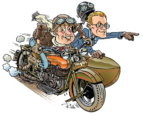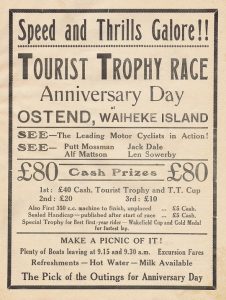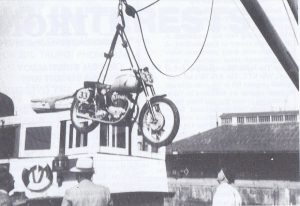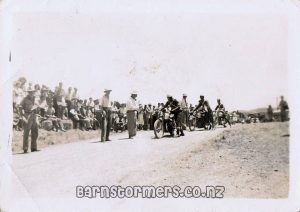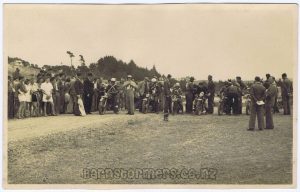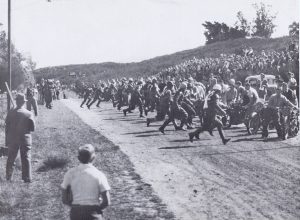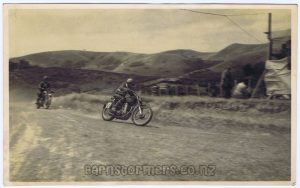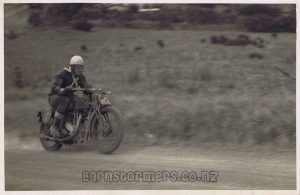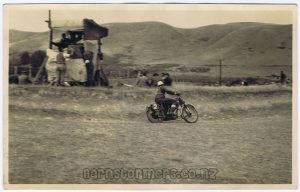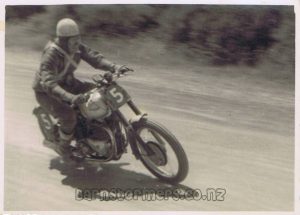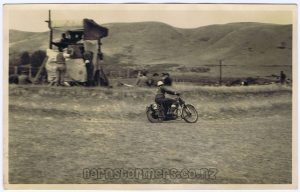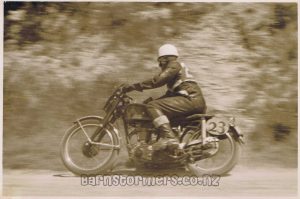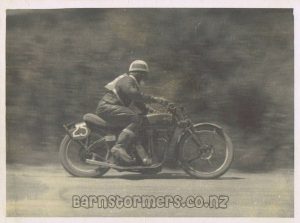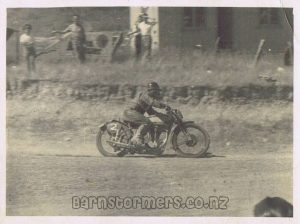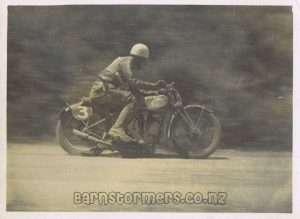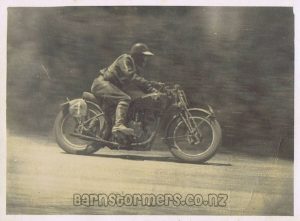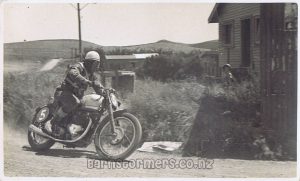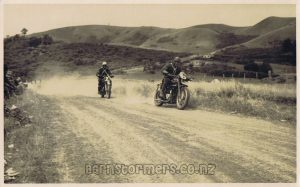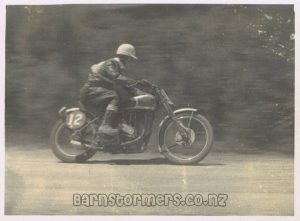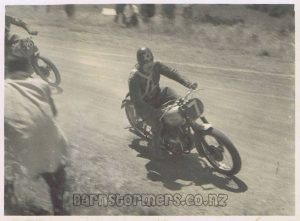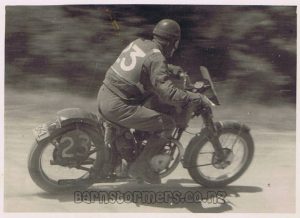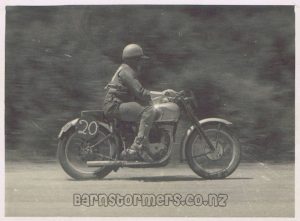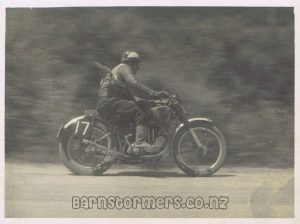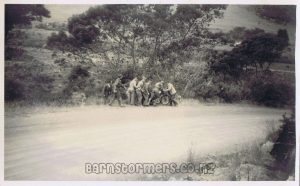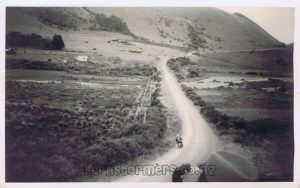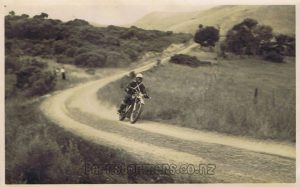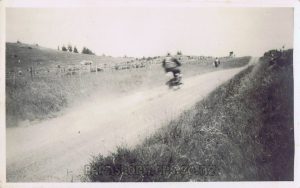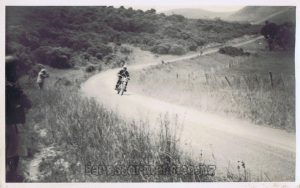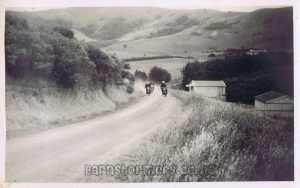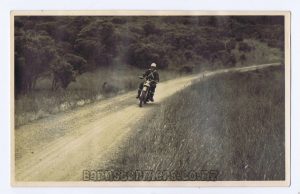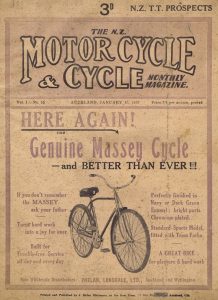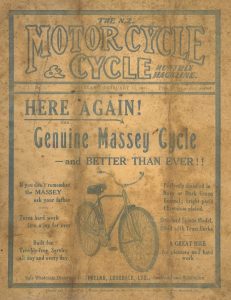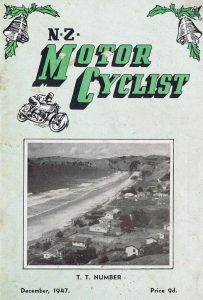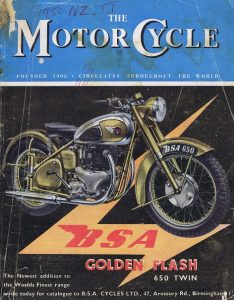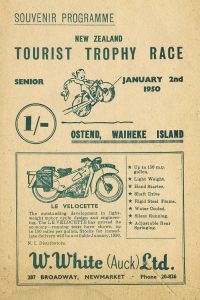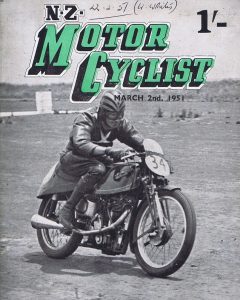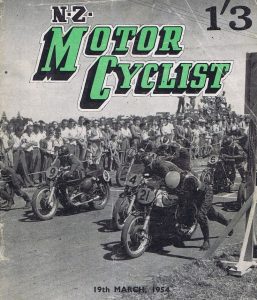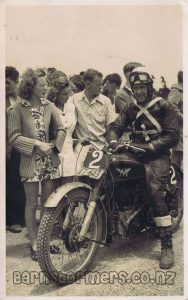69 years ago today motorcycle enthusiasts, both race entrants and spectators, would be packing up and heading back to Auckland on the ferry after the finish of the final race ever to be held on Waiheke Island. This was the Senior TT held on January 2nd 1950, and even though racing had run its course on the Island it was responsible for introducing some brilliant racers from New Zealand to the rest of the world. The racing on Waiheke went deeper than just a bunch of riders feeling the challenge of road racing.
We first wrote about the New Zealand TT on Waiheke Island way back in June 2013, outlining the first years and the competitors that raced there (click here to see that copy). Now with more information and photographs becoming available we are able to complete something that we started 6 years ago.
We all know that New Zealand is regarded as “the land too far” by most people in the northern hemisphere, and for a few in New Zealand the reverse also applies. This is not new, and for those who can only dream of opportunities abroad the cost of travel, time off work, and being away from family are important issues to be considered. Perhaps that’s why in the late 1920s a few keen Auckland motorcyclists decided to get together and create their own Ilse of Man style TT event for this side of the world. The aim was to create an event that mirrored the I.O.M TT, a remote island with a small population close to a major city that was serviced daily by a sea ferry, and Waiheke Island fitted those requirements exactly. The proposed event was organised by the then Sports Motorcycle Club (Inc) of Auckland. Just like the I.O.M TT the race was scheduled for the beginning of June, however the following year was changed to January as the weather was more suitable for road racing.
Following the true TT racing style the riders were sent off at fixed intervals, unlike the mass start that was used later on. Reasoning behind this would have been to lessen the risk of crashes or incidents that normally occur with the first few corners, and given the narrowness of the road being used was probably not a bad idea, but more importantly riders were racing for most against the clock and not against each other. This was most noticeable in this first event where Len Sowerby on the TT Douglas lead the majority of the race, however fell off just before the finish. He remounted and still took ‘line honours’ but on corrected time came in second because his total time to complete the race was approx 20 seconds longer than Sid Moses on the Rudge. The NZ TT is now a mass start with the first person over the finish line declared the winner, however the timed starting system still applies today in the Ilse Of Man TT racing with the winner being the rider with the least amount of time taken to complete the required laps.
Throughout the 16 years that the TT was held on Waiheke Island (remembering that there was no racing in war years) there were few changes made to the way the event was run, the most significant would have been in 1947 when the organisers expanded the racing into 2 classes. Up to 1947 there was just one class of all comers, for 1947 they introduced the Junior 350 and Senior 500 classes. Perhaps a safety initiative given the different speeds between the 350s and 500s, but most likely due to the popularity of the event with entry numbers steadily growing. Additionally it enabled riders to enter 2 machines for the 2 races with the possibility of increased monetary winnings. For the final event being held there were 23 entrants for the Junior and 29 entrants for the Senior races. Both races being 20 laps, a total of 100 miles. Prize money for the Junior class was paid down to fourth place, with 1st being £60, 2nd £30, 3rd £15, and 4th £5. The Senior class was, 1st £80, 2nd £40, 3rd £20, 4th £10, and 5th £5.
Most of us that are involved in older motorcycles who are well past that half century would have known of somebody who raced at, or just visited Waiheke as a spectator. I am no different. I worked with Eric Wainwright in the 1970s who raced there (race number 17 in the 1950 Senior), and then there was Arthur Beatson, a quiet unassuming little man who loved his Velocettes who was a spectator. Shame that I didn’t listen more closely to their stories. But regrets aside the TT did leave its footprint clearly in the memories of a lot of people.
Little did the organisers know when they set the wheels in motion for the first New Zealand TT in June 3rd 1931 of how popular the event was actually going to be, and of how important it would be in New Zealands motorcycle racing history.
Waiheke Island – The Place.
Situated just off shore from the city of Auckland in the middle of the Hauraki Gulf Waiheke was primarily a getaway or holiday destination for Aucklanders, even in the earlier years. Accordingly the permanent population was relatively small and the majority was seasonal. This meant that local council funding for improvements was limited so any revenue generated by other means, in this case motorcycle racing was greatly welcomed. Everything would have to have sent over by barge or scow, loading and unloading was a challenge and naturally everything was at the mercy of the sea.
So when it came to the racing it was never going to be an easy task for the organising committee. Sailing schedules, tides, competitors, accommodation, support crew, liason with island authourities all had to be carefully attended to. This would have taken months. Then the spectators also had to be really keen to attend. A trip into Auckland by whatever means, another journey by steam ferry to Waiheke Island, and then perhaps a brisk walk to get to their favourite campsite or viewing spot. Competitors, well they would have their camping/sleeping gear as well as having to sort their machine, spare parts and race fuel. Once again all at the mercy of the sea.
As with all types of motor racing practices are just as important as the racing itself. It allows the riders to familiarize themselves with the race circuit as well as the setting up of the machine with the correct carburation and gearing. For any rider this would be quite demanding, some riders would be working long hours to repair/modify their machines hoping to be completed in time to catch the steam ferry. All this had to be achieved before race day as the only practice was between 6am and 8am on race day.
Loading of a new racing GP Triumph for the trip to Waiheke Island in 1949. Perhaps a nervous moment for any rider/competitor to see their pride and joy swinging from a hook. This was no different to the transporting of motorcycles to the I.O.M TT, roll on, roll off ferries had yet to be built.
Getting starting positions sorted before the off.
From the Starters Gun (literally).
This photograph is from the the 1948 start and for this year it appears that a Le Mans type start was employed. This involved riders lining up on the opposite side of the race track to their machines, the race bike being held by a member of the pit crew. With the starters gun being fired the racers sprint across to their machines and push start off down the track. The starter is visible on the left holding the “official” starters gun.
The Racers
New Zealand has always produced excellent riders right from the inception of motorcycle racing. From the 1910s Allan Woodman with his one leg, and Percy Coleman, through to todays riders of Shaun Harris, Bruce Anstey and Andrew Stroud. Perhaps one thing that has contributed to their success is that most New Zealand riders are versatile and ride on road as well as off road – motocross, trails, and in the past – beach racing. The Waiheke riders were not be that different in that a lot of them raced in beach racing as well (click here to go to 1948 beach racing at Muriwai).
Caught out – and looking very guilty about it. A rider is only allowed assistance whilst in the pits, and that is for refueling only. Any mechanical adjustments had to be completed by the rider himself. When racing the rider is only allowed to carry a spark plug spanner, and external assistance from the viewing public to a disabled rider would result in disqualification – if caught. I wonder what the result of this situation was?
The Roads.
Here is a good indication of the roads that were raced. As can be seen even for 1948 they were not the best as the complete circuit was still unsealed. Fine weather conditions meant dust, and lots of it, whereas rain would turn the circuit into a mud bath.
Did you know?
That in the early years of racing on the island that first aid was carried out by a rider, with a sachel over his shoulder riding horseback around the circuit.
As with all important sporting events the media played their part in promoting the TT. Early New Zealand motorcycle publications are rare but for 1937 the January edition of The NZ Motorcycle and Cycle Monthly published a informative article on the running or lack of, of the TT at the beginning of January due to the excess rain causing at deterioration of the track surface. The race was postphoned until Anniversary weekend of the 29th January. Also included is an excellent breakdown of the racing for the first 6 years, 1931 to 1936 with some rare photographs of our early racing heroes.
Click on the cover below to see the January 1937 edition of the magazine.
It is a 5.4M PDF
As with all PDFs you will need Adobe Acrobat Reader to view it.
And for the results of the racing that was finally held on Anniversary weekend click on the February 1937 edition below.
It is a 1.7M PDF.
For 1947 the NZ Motor Cyclist did their best to be involved in the popular event. Below is an edited version of the December 1947 edition including a brief outline of the 1946/47 event. Contents also include a list of entrants for the 1947/48 races and a good description of how the racing event was run. The December 1947 edition was NZ Motor Cyclists 3rd publication.
Click on the cover to see the 13 page magazine.
It is a 4M PDF.
Even being on the far side of the world didn’t preclude us from being noticed by the main motorcycling 2 weekly/monthly magazines. The January 1950 issue of The Motor Cycle published a one page report on the last NZ TT to be held on Waiheke Island. The ‘modern’ telegraph of the time must have been busy working hard as the January copy came out in the UK on the 19th.
Click on the Gold Flash to see that article.
The Final Chapter.
By 1949 the population of Waiheke Island had been steadily growing. From small beginnings in 1926 of 421 residents, to 693 in 1936, to approximately 1500 in 1949 Waiheke (1) was starting to wake up. Whether it was this, the demands being placed on the islands resources including the ferries, the difficulty experienced by both competitors and spectators in getting to the racing, combined with the logistics of running such an event, especially with the remoteness of Waiheke Island, the Auckland Motorcycle Club was struggling and a decision was made that the 1949/50 event was to be the last. The club was not making any money with this event and with rising costs it was decided to relocate the event to the main land.
The chosen new venue was Seagrove, near Waiau Pa in South Auckland. It was a small disused WW2 Air Force Base and was being used for other motor sports events.
With day trips being easier spectator numbers were up and costs were down. The event was very successful and for the first time in quite a while a profit was shown from the new venue. However Seagrove wasn’t to last as a more suitable road circuit was found closer to Auckland. Despite the changes though, to some the Waiheke TT will be remembered as the first, and of course the best.
(1) The population of permanent residents in 2017 is approx 9,000 rising to 40,000 for the summer holiday season.
The last race program ever for the Waiheke TT, the Senior TT held on January 2nd 1950.
Seagrove- and the racing just gets better. Win Taylor on a KTT Velocette at Seagrove for the 1951 NZ TT.
The cover of the New Zealand Motorcyclist showing the start of the NZ TT being held at the Mangere circuit. Note the lack of secure barriers to keep the spectators back from the track. Very close viewing indeed!
The photograph album – the photographs used in this article, unless otherwise stated are from the collection of Digger Hallam. Digger was a keen motorcycle racer from the 1930s through to the 1950s, with his real success being the winner of the NZ TT in 1941. Referred by many as ‘a character’ many photos show a happy rider who seemed to enjoy what he did – racing motorcycles. Many thanks to Pete Butterworth for allowing us to use them.
Digger Hallam – The Racer.
Finally I would like to thank those who helped in the assembling of this article –
Pete Butterworth of Velocette fame who donated the Digger Hallam photographs and the early editions of The NZ Motorcycle and Cycle Monthly.
Mark James of the Waiheke Historical Society.
Without their help it would not have been possible to assemble this article on early motorcycle racing on Waiheke Island.
Is this the last of Waiheke and its racing history? Maybe, but if there are any more stories or photographs out there that can be shared we will happily put them up on Barnstormers. Talk to us through our contacts page. Our operators are standing by the phones now!
